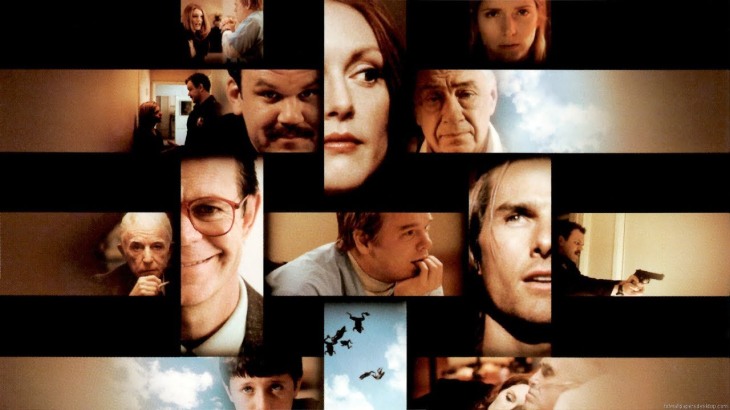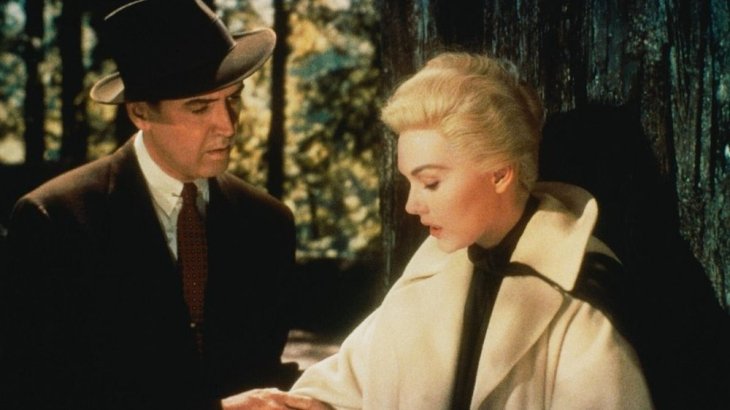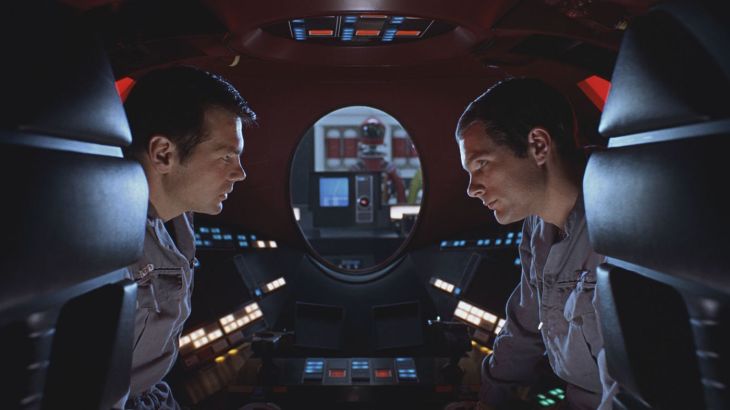Directed by: Paul Thomas Anderson
Cast: Tom Cruise [Frank T.J. Mackey], Philip Seymour Hoffman [Phil Parma], Julianne Moore [Linda Patridge]
On a random day in San Fernando Valley, a dying father, a young wife, a male caretaker, a famous lost son, a police officer in love, a boy genius, an ex-boy genius, an ex-boy genius, a game show host and an estranged daughter will each become part of a dazzling multiplicity of plots, but of one story.
My rating: 8/10

Narrative aspects
‘Magnolia’ is a film that has its storyline divided into different sections with the obvious weather forecast headings like ‘Light Showers. 99% Humidity. Winds SE 12 MPH.‘, and also the more frequent use of various characters and their lives which switch between each other. This allows the audience to finds breaks within the story and to shift their focus from one idea to the next, keeping them engaged in the film and attentive towards the plot point and perhaps the implicit details as well. Moreover, divisions between ideas are important for a film that is as long as two average length films, to not overwhelm an audience with an abundance of information for just one character. The length of this film is justified by the in-depth use of so many characters and backstories that seem to not connect but then eventually do. All characters relate to each other in some way, acting as parallels to each other, whether biologically or visited by another at a public place. It shows that even in reality, people’s lives can, in fact, overlap and a person may be going through the same situation or emotions as another. Though at the beginning of ‘Magnolia’ the similarity between the characters is unclear. However, an audience would expect that such a combination of characters coming together in the same town would eventually take place, otherwise the director of the film would not show these characters’ stories.
The film is covered in themes exhibiting key ideas that help an audience to sympathise, despise or understand characters and situations better, though also including Biblical allusions that serve as the interpretation of the famous frog scene in the film.
(covered in detail in the ‘favourite scene’ section)
- Relationships – The film depicts different kinds of human interactions like a husband and wife, a presenter and an audience, a father and a son or a nurse and a patient. These relationships allow the audience to observe various angles of probable life and understand the mood and atmosphere created. It is a theme since it is relationships that drive characters to make choices like committing suicide, meeting someone new or facing their fears, and it is this that allows the characters to grow and the story to progress forward.
- Pain – This involves both emotional and physical pain felt by the characters in the film. Every character has their own source of pain like Frank who is living with the emotional pain of his lost parents and Stanley who is pushed by his father to compete and succeed in a trivia game show. Moreover, physical pain is felt by Earl Patridge and Jimmy Gator in the form of their ever-growing cancer, which brings emotional pain to the loved ones around them. The film explores the different situations and reasons for pain and depicts how a certain individual could act and respond to it.
- Impurity – The film depicts characters that are going through a dose of ‘impurity’ like Claudia Gator and her drug intake, Linda Partridge and her adultery and Frank T.J. Mackey and his continuing game of lies revolving around his past. To add on, the other characters also display impurities in relation to their situation and story. In the end, all characters are seen with the struggle and the heavy-weight their guilt and regretful actions have put on them emotionally that they are seen broken down, with the aim of getting some help and being saved from the nightmare their sadly enduring. This drives the story to progress and also adds the suspense and tension which keeps the film engaging since the audience would not know how and if the characters would come out of the situation with success.
- Repentance & forgiveness – Characters look out for the forgiveness by their relatives and acquaintances for the ‘impurities’ they are guilty for throughout the film and in the past of their lives. Characters aim to restore their dignity and improve as people with an inner self-awakening and this drives them towards being committed in the film and pushing the plot forward.
Infer & Deduce: There are many ideas involved in finding a reason for naming the film ‘Magnolia’. The flower comes to mind at first, signifying the life cycle of an animate object which can be seen throughout the film where characters seem to be content at first but then something in their life tears them apart and brings them to their lowest. Flowers, in general, could symbolise blooming juxtaposed to withering. The meaning of Magnolias depends on the colour of the flower as well as the attitude of the person giving and receiving the flowers. White magnolias, in particular, symbolize purity and dignity which in the case of the film is quite ironic since every character is going through a state of impurity, whether it is the use of drugs, the abuse of parents or infidelity, which brings them to their downfall.
According to IMDb.com, ‘Magnolia’ may signify:
- Magnolia Blvd. is a street in the San Fernando Valley where the film takes place.
- Magnolia sounds similar to “Magonia”, a term created by Charles Fort (who wrote about strange phenomena and is referenced in the film’s closing credits) which is an alleged place in the sky where things are kept until they fall from it.
- There is a legend that the bark of the Magnolia tree can cure cancer.
All of the above points do apply to the film’s characters, plot and settings, further re-instating the fact that there is not only one reason for the film to be called ‘Magnolia’ and rather than just like the characters with varying identities, Magnolia’s meaning is subjective and can be applied to all of them.
Technical Aspects
Along with the astounding attention to detail in the narrative part of the film, ‘Magnolia’ exhibits an array of camera techniques used to convey certain emotions or plot points throughout the 3-hour time span of it. The ratio of freeze-frames (where the camera is still) to shots where camera movements are involved is significantly low.
- Pan and Tilt movements – These types of movements are used to follow characters in a scene. Panning is used as they walk from the left to the right, or vice-versa, parallel to the camera, moving on a fixed axis point. While titling involves the same concept though is done from top to bottom, or vice-versa, on a fixed axis point. These kinds of camera movements are not as active as dolly movements where the entire camera follows the subject, and allow an audience to observe the scene with more stability. An interesting use of the pan and tilt camera movements is with the Whip-Pan or Swish Pan, where the camera moves very quickly on the pan or tilt axis which causes a blur and can create a seamless continuous transition from one scene to another even if they have been shot at two different times and put together in post-production. In the film, it is used to transition from one character’s story to the other character, and appear to connect both timelines.
- Dolly and Zoon movements – This is a major technique used in various instances in the film to denote a sense of suspense and a rise in tension. The frame goes from a wide shot to a medium or closeup shot very swiftly, creating a fastened pace while emphasising on a certain character or object in a scene. This technique is achieved by using a dolly and physically moving the character towards or further away from the subject, or by using the internal built-in feature, zooming in or out, of the camera. While dolly is used to increase the intimacy between characters and other subjects, zooming in or out gives more of an on-looker sort of feeling, as if the audience is spying on the subject in the frame.
- Framing – The type of shots mostly consist of medium to medium-closeup shots of the subject, especially people, and are at eye level, whether they are standing or sitting. It is rarely done that the angle is higher or lower than that of the normal eye-level of a person. In terms of significance, it allows audiences to view all characters, regardless of what they are going through, how their personality is exhibited and what choices they make, to be assessed and judged as equals to each other. All the people in the film are going through their own subjective experiences and form them as individuals who either grow into greater individuals or succumb to the expectations of reality. What someone goes through, no matter how small or large, does not make them inferior or greater than anyone else. At our core, we are all equal and the perception of the clothes characters where, or where they live alters their status in our eyes.
- Other – Tracking shots that are not necessarily on a dolly (are hand-held, most likely being a Steadicam) are used in one particular scene where Stanley, the young boy visits the TV studio that conducts the trivia show he had been studying for, is being shown around the premises and the camera follows him but then shifts to following the presenter’s wife. The camera does not seem to make a cut and it follows the character like some sort of ever-watching entity, paying attention to all actions made by the character. This effect engages the audience’s attention into following the on-screen characters on their narrative journeys.
Favourite Scene
Up to this scene appearing on screen, the film captivated me through its multi-layered character portrayal and development and how the seemingly varied people linked up in some ways. Though once the first frog fell from the sky onto the windshield of Officer Jim Kurring’s police car, I was introduced to a wave of confusion, bewilderment and incapability of holding my laughter in. The rain of frogs was hilarious for me and I felt that it was so random for a film that made perfect sense up to this point. It was after the film ended that I researched the scene’s significance and found that it is quite symbolic.
The film uses a Biblical allusion of the plague of frogs to mirror the modern day situation to history:
(1) And the Lord spake unto Moses, Go unto Pharaoh, and say unto him, Thus saith the Lord, Let my people go, that they may serve me. (2) And if thou refuse to let them go, behold, I will smite all thy borders with frogs.
Exodus 8:1 & 2
The film refers to the numbers ‘8’ and ‘2’, at times even together, many times in hidden places subliminally. This clearly alludes to Exodus 8:2, a verse that happens to also mention frogs and an abundance of them, just like the film depicts. According to IMDb.com, the places where the numbers appear are as follows:
- Weather forecast: 82% chance of rain
- A gambler needs a 2 in blackjack but gets an 8
- Sydney Barringer’s mother and father’s apartment number is 682
- Right after Jim Kurring sees Donnie Smith climbing up the building, you can see a flash of a sign on the side of the road that says “Exodus 8:2? (it’s visible again when the frogs fall and hit Kurring’s car)
- In Marcy’s mugshots, her criminal record number is 82082082082
- In the bar scene, there is a chalkboard with two teams, the frog and the clouds, the score is 8 to 2
- A member of the game show crowd holds a placard with Exodus 8:2 written on it
- Jim says he gets off work at 8:00, and Claudia suggests they meet 2 hours later for a date
These are just a few of the examples where Paul Thomas Anderson uses the cleverness of scriptwriting and set design to really leave clues for the attentive members of the audience to spot and draw the connection to this very confusing frog scene. The verse from Exodus 8:2 refers to the story of Moses and how he was given a mission from God to convince the Pharaoh of Egypt to let the prisoners go so they may worship Him, and if the Pharaoh refuses, God “will plague all [the Pharoah’s] territory with frogs”. In the context of the film, it could refer to the ways in which the characters have drowned themselves in self-doubt and wrong-doings that it is time for them to turn to repent for their mistakes. The “Pharoah” could be a symbolism of the characters’ addictions (drugs), jobs (motivational speaker), relationships (husband and wife) and agendas (winning a competition), and that these people should prioritise and focus on the bigger picture and meaning of life and improve themselves. Though however, the audience sees the characters continue on the same path they started on and become rather worse in their behaviour or emotionally unstable which causes a rain of frogs to “cleanse” out the impurities caused by the ‘naive’ characters.
To add to the peculiarity of this scene, on the 28th of June in 1957 a weather phenomenon took place. Thousands of small fish, frogs and crayfish fell during a rainstorm at Magnolia Terminal near Thomasville, AL. Whether it is a coincidence that the numbers 8 and 2 were part of the date and the location of the incident was named Magnolia Terminal, or an act of a powerful entity on purpose is beyond comprehensible. It is quite interesting to ponder upon, being that this occurrence took place years before the film was produced and released. Paul Thomas Anderson could have taken some inspiration from this event which lines up very well with the Biblical verse.
Source: Climatological Data, Alabama
What would I do differently?
I immensely enjoyed the film, not expecting it’s extended length to deliver worthy entertainment and a story that was captivating in every scene. The two aspects I would alter would be the length since, for me, I feel that it would put off people from watching the film since it would seem like taking a major life decision since it takes a lot of time out of someone’s life. However, when considering the story and how heavily its audience captivation depends on the various characters having detailed backgrounds and somehow linking to one another, the 3-hour length seems to be appropriate. Regardless of this, the film did not seem boring at any point. To add on, the other aspect I would change would be the explicitness of the film, especially regarding Tom Cruise’s character. Though however, his actions and attitude did contribute to the understanding and interpretation of his personality and reasons behind what he chooses to do.
Further Research Areas:
Meaning of frogs in the movie “Magnolia”
ABUNDANCE OF SYMBOLS IN `MAGNOLIA’ HAS FILMGOERS LOOKING FOR CLUES – Chicago Tribune
Magnolia and Meaning – Culture Snob




